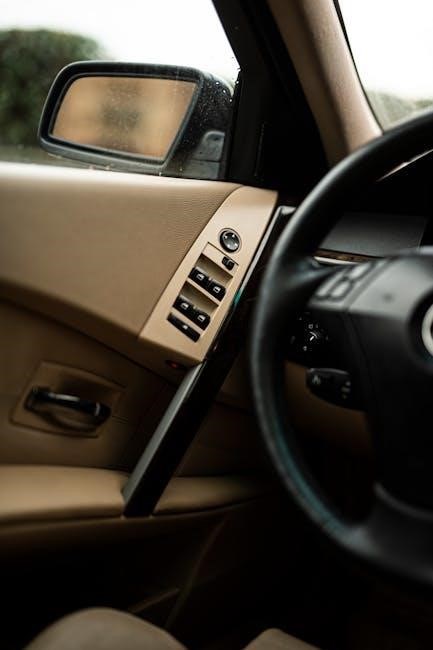The New Hampshire Driver’s Manual is a comprehensive guide for residents seeking to obtain or renew a driver’s license; Available in PDF and audio format, it covers essential road rules, traffic laws, and safe driving practices. This manual is designed to help new and experienced drivers alike understand state-specific regulations and prepare for licensing tests.
Purpose and Importance of the NH Driver’s Manual
The NH Driver’s Manual is designed to educate drivers on traffic laws, road safety, and best driving practices in New Hampshire. Its primary purpose is to ensure that all drivers understand the rules of the road, promoting safe and responsible driving habits. The manual serves as a key resource for individuals preparing for driver’s license tests, providing detailed information on state-specific regulations. By following the guidelines outlined in the manual, drivers can reduce the risk of accidents and contribute to safer roadways. It is a free, accessible resource that helps both new and experienced drivers stay informed and compliant with New Hampshire’s driving laws.
Availability of the Manual (PDF and Audio Formats)
The New Hampshire Driver’s Manual is conveniently available for download in PDF format from the official DMV website at www.nh.gov/dmv. Additionally, an audio version has been introduced to cater to individuals who prefer listening or have visual impairments. This audiobook can be accessed online, making it easier for everyone to study the manual. The PDF version allows users to carry the manual digitally, eliminating the need for a physical copy. Both formats ensure that drivers can study the manual at their convenience, whether at home, on the go, or in a classroom setting. This accessibility initiative by the NH DMV promotes inclusivity and ease of preparation for all applicants.
Key Topics Covered in the Manual
The New Hampshire Driver’s Manual is a comprehensive guide that covers essential topics to help drivers prepare for the road. It includes detailed information on road rules and traffic laws, such as speed limits, right-of-way rules, and traffic violations. The manual also emphasizes safe driving practices, including defensive driving techniques and how to handle emergency situations. Additionally, it provides guidance on license types and restrictions, as well as the requirements for obtaining a Commercial Driver License (CDL). The manual is designed to ensure that all drivers, whether new or experienced, are well-informed and prepared to operate a vehicle safely and responsibly in New Hampshire.

Eligibility and Documentation Requirements
To obtain a driver’s license in New Hampshire, applicants must meet specific eligibility criteria and provide required documentation. Visit the DMV website for details on necessary documents and requirements.
Driver License Eligibility Criteria in New Hampshire
To apply for a driver’s license in New Hampshire, applicants must meet specific eligibility criteria. These include being at least 16 years old for a youth operator license, passing a vision test, and providing proof of identity, residency, and legal presence. Additional requirements may apply for minors, such as completing a driver education course or obtaining parental consent. Applicants must also demonstrate an understanding of traffic laws and safe driving practices. The New Hampshire Driver’s Manual outlines these requirements in detail, ensuring applicants are fully prepared to meet all necessary standards for obtaining a license.
Required Documentation for Applying
Applicants for a New Hampshire driver’s license must provide specific documentation to verify their identity, residency, and legal presence. Required documents include a valid birth certificate, social security card, and proof of residency, such as a utility bill or bank statement. Additional documentation may be needed for minors, such as parental consent forms. The New Hampshire DMV website provides a detailed list of acceptable documents. It is essential to ensure all documents are valid and up-to-date to avoid application delays. Applicants should review the requirements carefully before visiting a DMV office to apply for their license.
Fees Associated with Driver Licenses
The fees for obtaining a driver’s license in New Hampshire vary based on the type of license and the applicant’s age. A standard driver’s license typically costs $50 for a five-year license, while a youth operator license (under 21) costs $30. Additional fees may apply for commercial driver licenses (CDL) or other specialized licenses. Payment can be made via cash, check, or credit card at DMV offices. It’s important to verify the most up-to-date fee schedule on the New Hampshire DMV website or by contacting local offices directly. These fees help fund road maintenance and safety programs across the state.

Road Rules and Traffic Laws
The New Hampshire Driver’s Manual outlines essential road rules and traffic laws, including right-of-way guidelines, speed limits, and proper responses to road signs and signals. These regulations promote safe and orderly driving practices for all road users. Adhering to these laws is crucial for maintaining road safety and avoiding violations. The manual also emphasizes the importance of staying informed about state-specific traffic rules to ensure compliance and responsible driving. By understanding and following these laws, drivers contribute to safer roadways across New Hampshire. Always refer to the official manual for detailed information. Stay informed to drive safely.
Overview of Road Signs and Signals
The New Hampshire Driver’s Manual provides a detailed overview of road signs and signals, essential for safe driving. These include warning signs, regulatory signs, and construction signs, each designed to guide drivers and ensure compliance with traffic laws. Understanding these signs is critical for navigating roadways effectively and avoiding potential hazards. The manual also covers traffic signals and pedestrian signals, emphasizing their role in maintaining order and safety. By familiarizing oneself with these signs and signals, drivers can make informed decisions and reduce the risk of accidents. The manual is available in PDF and audio formats, making it accessible to all learners. This section is vital for both new and experienced drivers to stay informed and drive responsibly.
Speed Limits and Traffic Violations
The New Hampshire Driver’s Manual outlines the state’s speed limits and the consequences of violating them. Speed limits vary by location, with maximum limits set at 70 MPH on rural highways and lower in urban and school zones. The manual emphasizes the importance of adhering to posted limits to ensure safety and avoid traffic citations. Violations can result in fines, increased insurance rates, or even license suspension for repeat offenses. Understanding speed limits and their enforcement is crucial for responsible driving. The manual also provides guidance on how to handle a traffic stop and the process for addressing citations. Adhering to speed laws is essential for maintaining safe roadways.
Right-of-Way Rules
Right-of-way rules in New Hampshire are essential for maintaining safe and orderly traffic flow. The manual emphasizes understanding when to yield to other drivers, pedestrians, or emergency vehicles. At intersections, drivers must yield to traffic already in the intersection or approaching from the right. When encountering a four-way stop, the vehicle arriving first has the right-of-way, or the vehicle on the right if arrival is simultaneous. Pedestrians always have priority in crosswalks. Additionally, drivers must yield to emergency vehicles with flashing lights or sirens. These rules are critical for preventing accidents and ensuring smooth traffic movement. Familiarity with these guidelines is vital for all drivers.

Safe Driving Practices

Safe driving practices in New Hampshire emphasize staying alert, adhering to speed limits, and using signals. Maintain a safe distance and avoid distractions to reduce accidents and promote roadway safety.
Defensive Driving Techniques
Defensive driving techniques are crucial for safe driving in New Hampshire. These strategies include maintaining a safe distance, anticipating other drivers’ actions, and being vigilant for unexpected situations. Proper use of mirrors, signaling, and controlling speed are emphasized to minimize risks. Avoid distractions like using a phone while driving to stay focused on the road. Staying calm and patient in heavy traffic is also encouraged to prevent aggressive driving behaviors. By adopting these practices, drivers can significantly reduce their chances of being involved in accidents and ensure a safer environment for all road users.
Sharing the Road with Other Vehicles
Sharing the road with other vehicles requires courtesy, awareness, and adherence to traffic laws. Always maintain a safe distance from other vehicles to allow time to react. Be cautious of larger vehicles like trucks, which may have blind spots. When interacting with motorcycles or bicycles, give plenty of space and check for their presence before changing lanes. Use signals consistently to communicate your intentions to other drivers. Avoid aggressive behaviors such as tailgating or weaving in and out of lanes. Respect the right-of-way rules and be patient with slower-moving vehicles. By fostering a cooperative driving environment, you contribute to safer and more efficient roadways for everyone.
Handling Emergency Situations
Handling emergency situations requires quick thinking and calm decision-making. Always keep an emergency kit in your vehicle, including items like a first-aid kit, flashlight, and reflective triangles. If you encounter a breakdown, move to a safe location, such as the shoulder, and turn on hazard lights. Stay inside the vehicle and call for assistance. In the event of an accident, assess injuries, provide aid if trained, and contact emergency services. Never leave the scene of an accident. Be prepared for unexpected weather conditions by slowing down and increasing following distance. Stay alert and follow traffic laws to minimize risks and ensure safety for all road users.

License Types and Restrictions
New Hampshire offers various driver license types, including commercial and non-commercial licenses, each with specific requirements. Restrictions may apply based on age, vehicle type, or driving endorsements.
Types of Driver Licenses in New Hampshire
New Hampshire provides several types of driver licenses to accommodate different needs. The most common is the Class D license for passenger vehicles. Young drivers may start with a learner’s permit before progressing to a probationary license. For commercial drivers, a Commercial Driver License (CDL) is required, with endorsements for specific vehicle types like trucks or buses. Non-commercial licenses include options for motorcycle operation with a Class M endorsement. Each license type has unique eligibility criteria and restrictions, ensuring safe and lawful driving privileges across the state.
Commercial Driver License (CDL) Requirements
Obtaining a Commercial Driver License (CDL) in New Hampshire requires meeting specific criteria. Applicants must be at least 21 years old and pass a medical examination to ensure physical fitness for operating heavy vehicles. A valid New Hampshire driver’s license is also necessary. The process involves passing a vision test, a written knowledge test, and a skills test, which includes pre-trip inspections, basic vehicle control, and on-road driving. CDLs are classified into Class A, B, and C, depending on the type of vehicle and its weight. Additional endorsements may be required for specialized vehicles like tankers or buses. The manual details these requirements to help applicants prepare effectively.

Driver License Testing and Preparation
The New Hampshire Driver’s Manual helps prepare for written and vision tests. Study tools include the PDF manual, audio format, and online practice tests for effective preparation.

Written Test and Vision Requirements
To obtain a driver’s license in New Hampshire, applicants must pass a written test and a vision exam. The written test covers traffic laws, road signs, and safe driving practices, as outlined in the NH Driver’s Manual. The manual is available in PDF and audio formats, making it accessible for all learners. The vision test ensures applicants can see well enough to drive safely. Studying the manual thoroughly is crucial for success, as it includes all necessary information for the test. Additionally, online practice tests are available to help applicants prepare effectively for the written exam.
Road Test Preparation Tips
Preparation for the road test in New Hampshire involves practicing standard vehicle control and driving maneuvers. Study the NH Driver’s Manual to understand traffic laws and safe practices. Practice common test maneuvers, such as three-point turns, parallel parking, and lane changes. Familiarize yourself with the test route and vehicle operation. Ensure your vehicle meets safety standards and is properly registered. Practice in various driving conditions, such as urban and rural roads, to build confidence. Use online practice tests to assess readiness. Stay calm and follow the examiner’s instructions to demonstrate your driving skills effectively.

Vehicle Safety and Maintenance
The New Hampshire Driver’s Manual emphasizes the importance of vehicle inspection and regular maintenance to ensure road safety. It provides a detailed vehicle inspection checklist and tips for maintaining your vehicle.
Vehicle Inspection Checklist
The New Hampshire Driver’s Manual includes a detailed vehicle inspection checklist to ensure roadworthiness. It covers critical components such as tires, brakes, headlights, taillights, and turn signals. Drivers are advised to check fluid levels, including oil, coolant, and windshield washer fluid, and ensure proper function of wipers and horns. The manual also emphasizes inspecting mirrors, seat belts, and airbags for safety. Regular inspections help prevent mechanical failures and accidents, while also ensuring compliance with state safety regulations. This checklist serves as a practical guide for maintaining vehicle safety and reliability on New Hampshire roads.
Regular Maintenance for Safe Driving
Regular vehicle maintenance is crucial for safe driving and extending the life of your car. The New Hampshire Driver’s Manual recommends following a routine maintenance schedule to ensure optimal performance. This includes oil changes every 5,000 to 7,500 miles, tire rotations every 6,000 to 8,000 miles, and regular fluid checks for coolant, transmission, and brake systems. Drivers should also inspect and replace air filters and belts as needed. Checking tire pressure monthly and ensuring proper brake function every 10,000 to 15,000 miles are essential. Adhering to these practices helps prevent mechanical failures and ensures your vehicle operates safely on the road.

Additional Resources and Support
The New Hampshire DMV offers online study tools, practice tests, and interactive guides to aid in preparing for driver exams. Visit the official NH DMV website for detailed resources and support.
Online Study Tools and Practice Tests
The New Hampshire DMV provides a variety of online resources to help drivers prepare for their exams. These include interactive practice tests, which simulate the actual written test, covering topics such as road signs, traffic laws, and safe driving practices. Additionally, the official NH driver’s manual is available in PDF format, allowing users to study at their own pace. For those seeking extra support, there are online study guides and AI-powered chat tools that offer personalized assistance. These resources are designed to ensure that applicants are well-prepared and confident when taking their driver’s license exams.
Contact Information for DMV Offices
For assistance with driver’s license-related inquiries, the New Hampshire DMV offices provide convenient contact options. Residents can reach the DMV by calling (603) 522-6877 or visiting their official website at www.nh.gov/dmv. Physical locations, such as the Lakes Region Driver Education office at 21 Cosmar Dr, Sanbornville, NH 03872, offer in-person support. The DMV website also provides detailed contact information for all offices statewide. Visitors can use these resources to schedule appointments, request forms, or seek clarification on licensing processes. This accessibility ensures that applicants can efficiently navigate the requirements for obtaining or renewing their driver’s licenses in New Hampshire.
The New Hampshire Driver’s Manual serves as an indispensable resource for all drivers, providing detailed insights into road rules, safety practices, and licensing requirements. By covering topics from traffic laws to vehicle maintenance, the manual ensures that drivers are well-prepared to navigate the state’s roadways safely. Its availability in PDF and audio formats makes it accessible to everyone. Whether you’re a new driver or seeking to renew your license, this guide is a valuable tool. Stay informed, follow the rules, and contribute to making New Hampshire’s roads safer for everyone. The DMV’s commitment to clear and comprehensive resources helps maintain responsible driving practices statewide.

Leave a Reply
You must be logged in to post a comment.